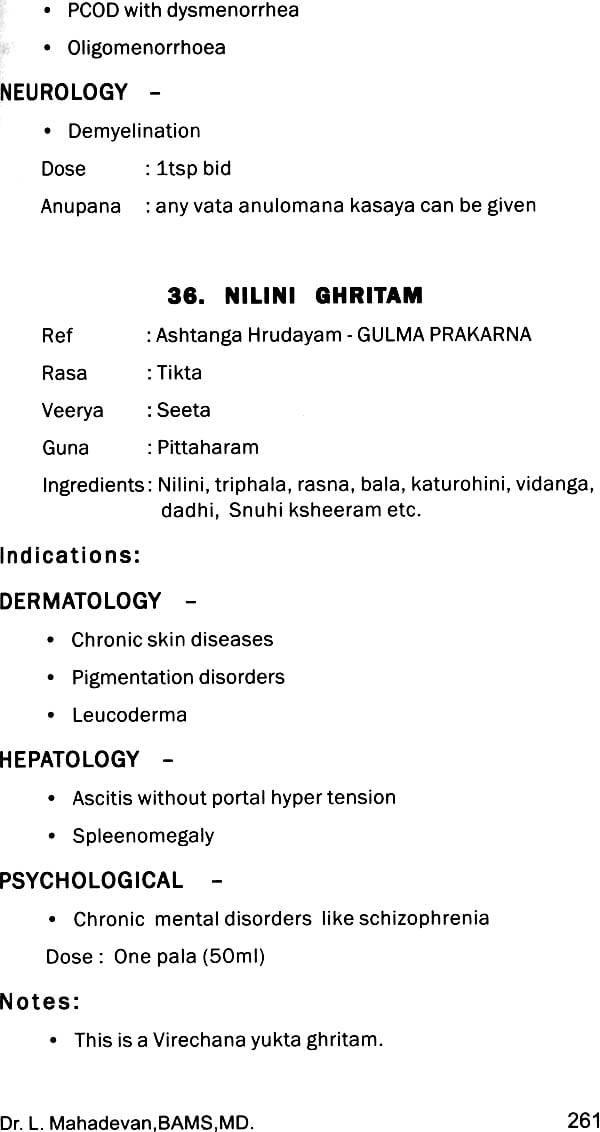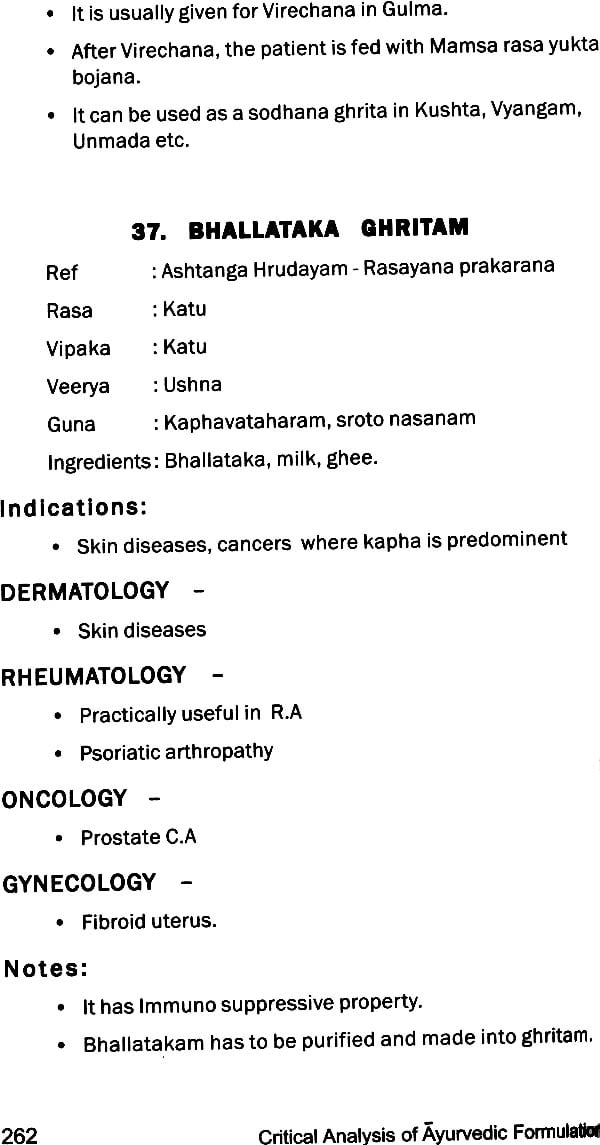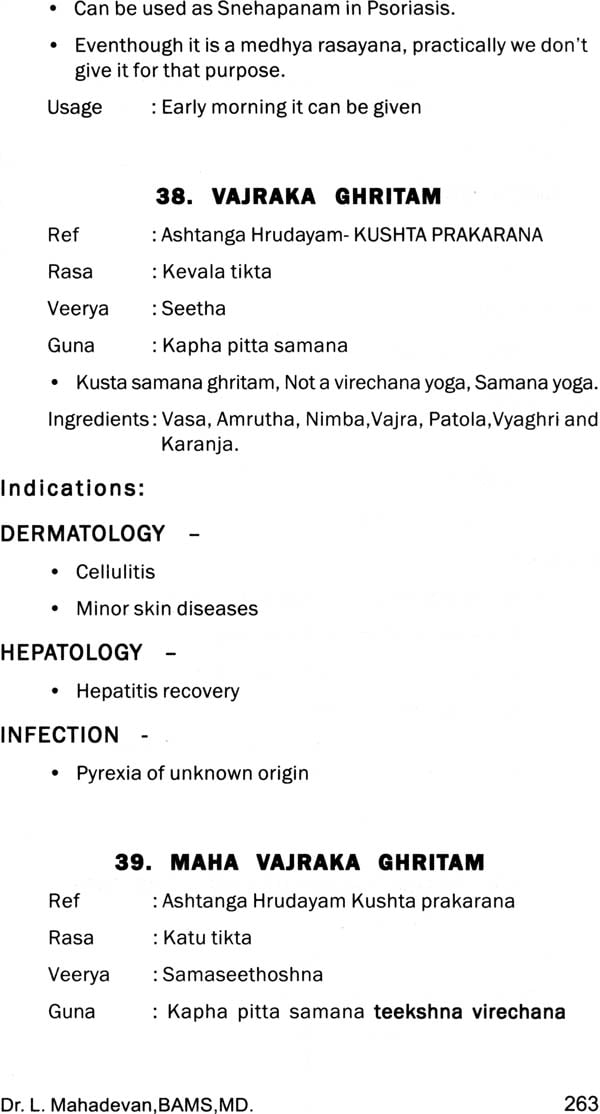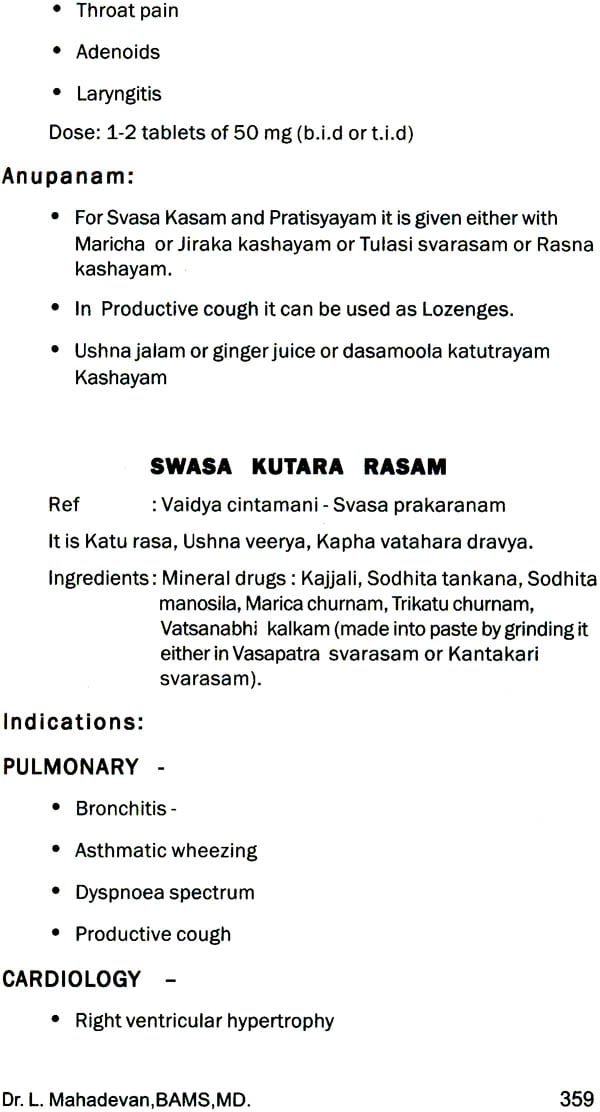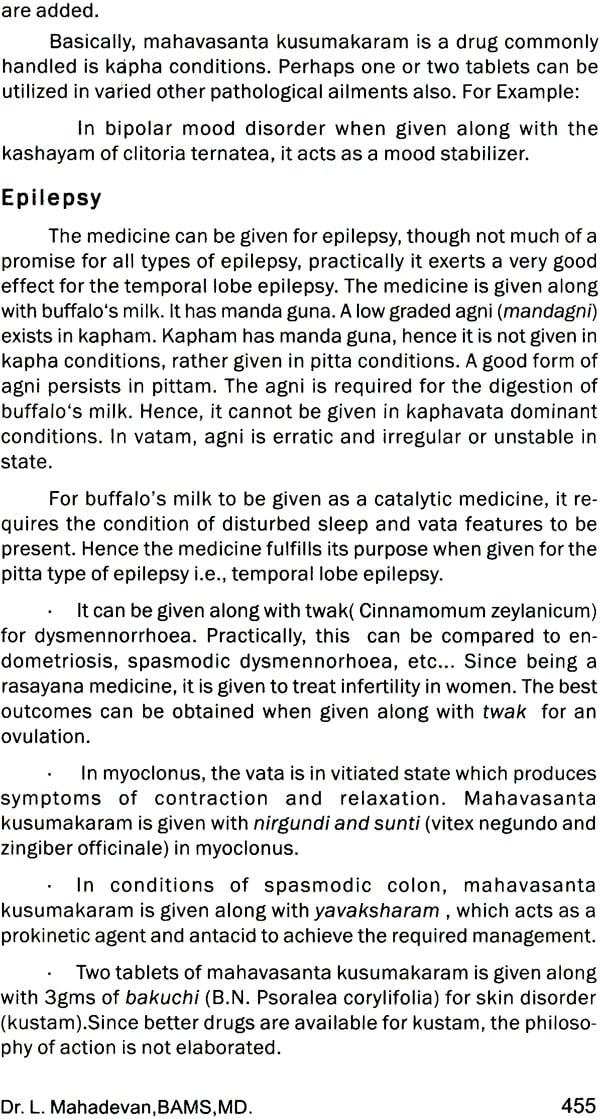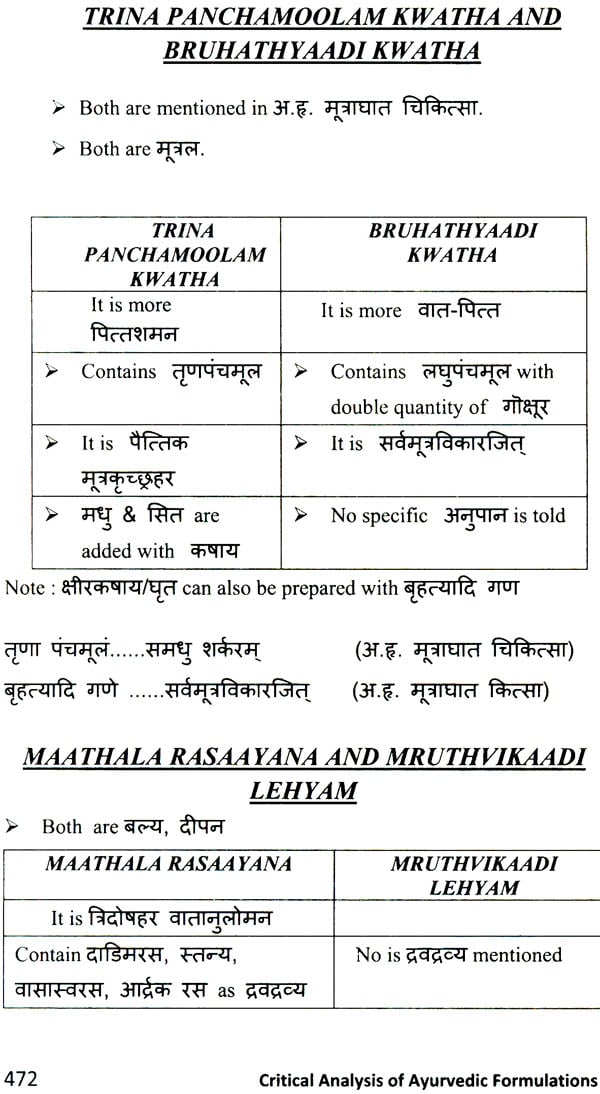
Critical Analysis of Ayurvedic Formulations (Sahasrayoga and Other Samhitas)
Book Specification
| Item Code: | NAK515 |
| Author: | Dr. L. Mahadevan |
| Publisher: | Ayurvedic Educational and Charitable Trust |
| Language: | English |
| Edition: | 2018 |
| Pages: | 480 |
| Cover: | Paperback |
| Other Details | 8.5 inch x 5.5 inch |
| Weight | 500 gm |
Book Description
About the Author
Dr. L. Mahadevan completed his post graduation M.D Kayacikitsa, from Government Ayurveda College, Thiruvananthapuram with high academic credentials. He does intensive research in Neurology and Panchakarma. He has his practice in Derisanamcope (A village in Kanyakumari district, Tamilnadu) and in Chennai and he teaches clinical medicine to Ayurvedic students. His classes on clinical medicine are unique in nature. He has written Sixty books on Ayurveda. He is a student of Dr. B. Vaidyanathan.
Preface
I am very happy to publish this book by the name of my student community. Bhishak, dravya, upastha, rogi are considered as pada catushtaya.
When we grow by constant study and by clinical update at one level we become skillful. Then we need good drugs for our practice. We will always ask what is the medicine, where is the medicine, is there anything new what I can contribute to this, utilize in this condition. So dravyas are very important and we have got so many formulations in our tradition. Every state has followed a particular text. Other than the text there are traditional recipes, local recipes, some of the recipes that are used in the family etc., One of the master whom I met told me that in Bengal they use Vangasena, in Gujarat they use Cakradatta, in Madhya Pradesh they use Siddha Yoga Sangraha; In Kerala they use Sahasrayogam, Arogyaraksha kalpadrumam; In Tamilnadu they use Padartha guna sinthamani, In Andhra they use Basavarajeeyam, in some part Bhaisajyaratnavali and it goes like that.
So these books are written based on the flora available in that particular place. If you take Kanyakumari District, the Nadar community had contributed so much in the preparation of kashayams and tailams which are remarkable. These herbs are not mentioned either in Ayurvedic text or in Siddha text which I am commenting upon separately in the form of another book.
It is not possible for a student to by heart all the yogas in his life. So when he wants to know about a yoga in our tradition I ask him to read the following things.
Where the yoga is mentioned and the chapter name
What is the first phalasruti mentioned in that yoga For example, the first phalasruti of agasthya rasayanam is valipalitham. You should know that when a person who is having bronchial asthma is having hair issues, automatically the prescription should go to agasthya rasayana. Then you should know the dosha pratyaneeka property of that yogam. For example, Gandarvahastadi or dadimathi is moodavata anulomana, then you should know about the vyadhipratneeka property of that yogam.
Sahacharadi tailam is used for kampa vata, then you should be knowing about the upayapratyanika property of that yogam. For example, Thippili rasayanam, lehyam, is vatakapha haram and useful in bronchial asthma which is a vatakapha disease. Then Mukhya dravya visesatvam the main ingredient of abhayarishtam is amalaki. Prakarana visesatvam the chapter in which the yoga is told. Padavanala curnam that is told in arso ciktisa. All these things we teach. People were highly impressed and motivated by my classes, were asking me to give these ideas in the form of a booklet so that the essence of the whole text can be easily understood. With that vision I have made this book.
I am highly thankful to my beloved students Dr. Arif Khan.J.S and Dr. Gayathri.R for supporting me continuously by working day and night in finishing the work. They did this as a yagna. They will be remembered always by all the students all over the world who read this.1 bless them from my heart for a good and successful clinical journey which they have started with me.
This book will be highly useful to you which will change your thinking pattern. We did not write the original sloka, because the original sloka you can read from the book. This is my idea. So, we always request you to read the original sloka as nothing can substitute the original one.
I have given modern terms for particular diseases, based upon my own clinical experience.
For example, pittaja udavartha I have interpreted as GERD, Vata gulmam I would have interpreted as non ulcer dyspepsia.
You have to sit with me in my clinic to know the preciseness of the drug selection and you are welcome to do that. I wish my Guru Dr. B. Vaidyanadhan is there to see all these things.
May Lord Baghavan Dhanvantari, Agasthya Muni, Abhirami Amba Samedha Kalasamharamurthy bless you all with health, prosperity and wisdom in your clinical practice.
Foreword
Ayurveda has touched our lives so deeply that it has become almost impossible to ignore its existence, let alone it's important. Ayurveda is a gift, the oldest healing science that has been helping human being to live a healthy and ethical life for centuries. Dr. L. Mahadevan, through his lifelong and dedicated service towards Ayurveda and humanity has proved himself to be a true scholar of this divine and close to nature branch of herbal medicine and healthcare treatments.
While dealing with the patient with the help of Ayurveda, Ayurvedic practitioners often face difficulties to choose perfect medicine for proper cure. This book, Gunavikalpa is meant to deal with these difficulties and make the subject understand to Ayurvedic practitioners without leaving the slightest doubt. Nowadays, people are getting more and more interested in Ayurvedic Medicine and treatments. Now, it is upon us to grab this opportunity and prove to the world that Ayurveda truly is a logical, reproducible, scientific, tested, and evidence based medical system.
Ayurveda is so improved and so effective that not only patients but also the physicians from other branches of medicine are looking at it for some answers where their own streams have failed to explain it. The diseases which have been proven untreatable through conventional medical process now are being treated successfully with Ayurveda. Many thanks to the doctors like Dr. L. Mahadevan, who has been trying very hard to bring the true and extremely beneficial nature of Ayurveda out to see everyone.
There is no doubt that Ayurveda is more than equal to other medical streams, yet there exists a substantial scope for future improvements. There are still thousands of things which are waiting to be revealed and will always be. The process of improvisation never ends. This book is going to play a crucial role in this process. In this book, Dr. L. Mahadevan has integrated Ayurvedic medicine with modern day diseases very effectively.
This book will prove extremely useful for all Ayurvedic Practitioner as Dr. L. Mahadevan has revealed in detail all commonly used and easily available Yogas in it. Going beyond the doctors and practitioners the book reaches to the students of every medical stream and helps them to understand the subject from pre to pro. I have no doubt that in the nearest future this book will have earned a place on the table of every Ayurvedic physician as a ready reference.
In this book we find a beautiful and unique combination of different medicines which highlights a new aspect of Ayurveda. The author has explained it so simply and modern way that any Vaidya or Practitioner can use all the drugs mentioned in the book with ease and practice full-fledged.
The book also contains all the Yogas from Sahastrayogam and other Granthas like Ashtanghradayam, Bhaishaj Ratnawali, Sharangdhar Samhita, Yogratnaragini etc. with detailed instructions. These yogas are very typical and commonly used in Kerala. With no instructions and proper guidance these yogas and drugs seem to be difficult to use for practitioners at the beginning. This book has solved that problem for good. With the help of this book use of these yogas and drugs has become possible for every Ayurvedic Practitioner.
All the yogas and druges suggested in the book are described with reference of rasam, viryam, guna, doshaghata and ingredients. Some of the drugs have been explained as per awastha viz. gangadhar churna which is used in diarrhoea and dysentery and it should be used only after amavastha for stambhanam
The author has mentioned merits and contraindications concerning some drugs very clearly in the book. Only a confident man and an experienced practitioner can do this. Some of the drugs are described by two different names i.e. Guggul Panchapala churnam in Sahastrayogam and Swayabhu Guggul in the book by Arun Datta. Author's special notes are the key point of the book. For example, author has advised to stop continous use of Guggultaktakam kashay to avoid pittaprakop by Bhalatakam and other drugs.
While creating this book, Dr. L. Mahadevan has left no room for any kind of ambiguity. He has put every feeling and fact in precise manner . .This is want makes this book unique and puts it on top of the list.
Contents
| I. | ARISHTAM | 40 |
| II. | BHASMAS | 71 |
| III. | CHOORNAM | 94 |
| IV. | KASHAYAM | 137 |
| V. | GHRITAM | 228 |
| VI. | GUTIKA | 274 |
| VII. | LEHYAM | 325 |
| VIII. | RASAOUSHADI ` | 349 |
| IX. | TAILAM | 386 |
| X. | DHUMAPANA YOGAS | 442 |
| XI. | KARNAPOORANA YOGAS | 443 |
| XII. | NASYA YOGAS | 444 |
| XIII. | VIRECHANA YOGAS | 449 |
| XIV. | KSHEERA KASHAYA YOGAS | 451 |
| XV. | COMPARISON OF FEW FORMULATIONS | 458 |
